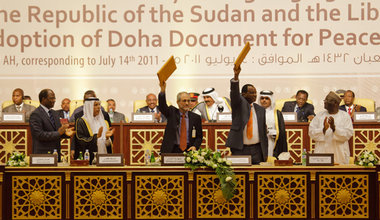Darfur Peace Agreements: Challenges and Opportunities
One year after the adoption of the Doha Peace Document, Voices of Darfur examines the evolution of the negotiations and the challenges they have faced.
By Abdullahi Shuaibu
The conflict in Darfur has led to nearly two million displaced persons living in camps spread around the region and hundreds of thousands of refugees living in Chad and the Central African Republic. Several actors have engaged in the search for an effective and sustainable peace agreement that not only will successfully address the root causes of the conflict and enable the return of displaced people but also will bring Darfur’s armed movements and the Sudanese government to common ground.
The history of the Darfur peace process dates back to September 2003 and the mediation of the Chadian government in the Abeche Peace Talks, which led to the first ceasefire agreement between Sudan and the Sudan Liberation Army (SLA). While the conclusions of the talks were not formally implemented, they were considered the first clear declaration of the political nature of the conflict and the growing international concern. The talks also represented the beginning of the African Union’s efforts to take the lead on addressing the situation.
The first official talks mediated by the AU were held on 8 April 2004 in N’Djamena, Chad, where a ceasefire humanitarian agreement was signed. The African Union mediation then moved to the AU’s headquarters in Addis Ababa, Ethiopia, where an agreement on establishing a ceasefire commission and the deployment of observers in Darfur was signed on May 2004.
Former Nigerian President and then AU President, Olusegun Obasanjo, moved the negotiations to Abuja, Nigeria, where six rounds of peace talks were held in the run-up to the signing of the Darfur Peace Agreement (DPA) on 5 May 2006 by the Government of Sudan and SLA Minni Minawi. Unfortunately, while the talks resulted in two protocols, a declaration and an agreement, the agreement was not supported by the two major movements, Justice and Equality Movement (JEM) and SLA Abdul Wahid, or other smaller movements.
[…]
Read the full article in the July 2012 issue of Voices of Darfur. Download the magazine (PDF) here.

On 14 July 2011, the Government of Sudan and the Liberation and Justice Movement signed the Doha Darfur Peace Document in Doha, Qatar. From left to right are Djibril Bassolé, Joint Chief Special Mediator (Burkina Faso), Ahmad Bind Abdulla Al Mahmound, Minister of State for Foreign Affairs (Qatar), Dr. Ghazi Salah Eldeen Atabani, Presidential Advisor, Dr. Elitigani Seisi Mohamed Ateem, Chair of the Liberation and Justice Movement (LJM) and Ibrahim Gambari, UNAMID Joint Special Representative. Photo by Olivier Chassot, UNAMID.

 UN
UN United Nations Peacekeeping
United Nations Peacekeeping


